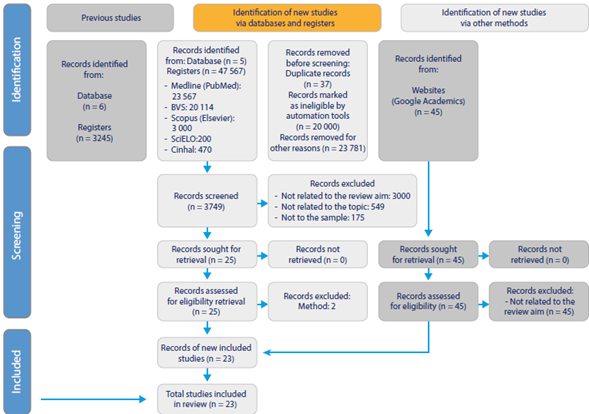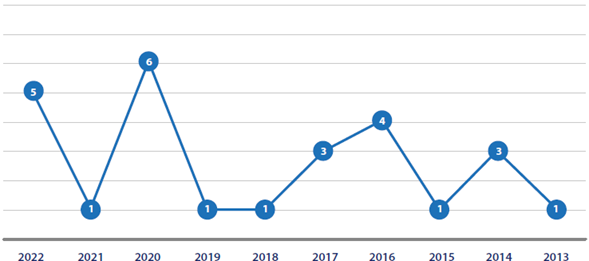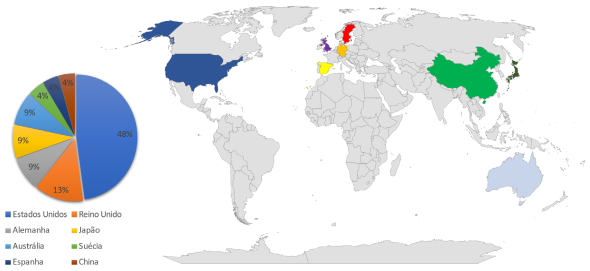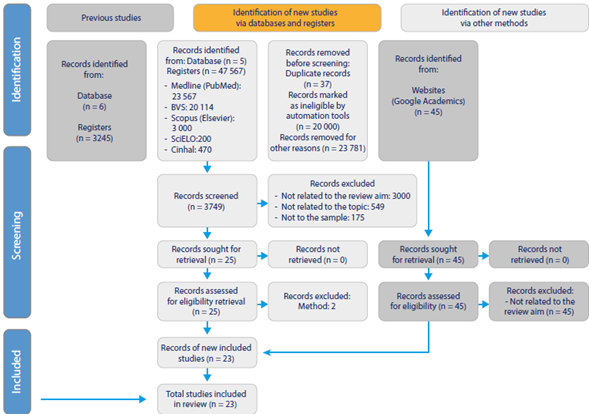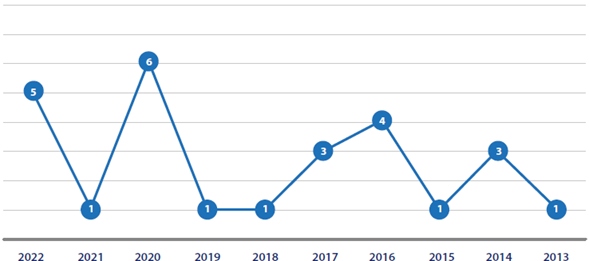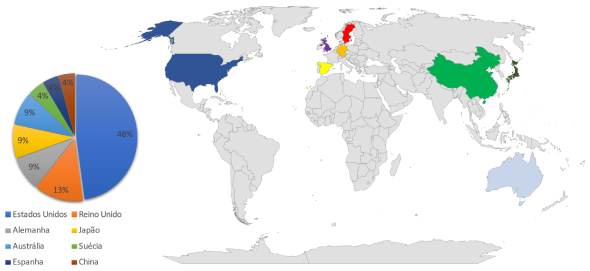|
Quality and availability of information in
primary healthcare:
The patient perspective(27)
|
2020/VI
|
Suécia
|
Explorar experiências vividas de pacientes se comunicando e recebendo informações
da APS.
|
Estudo qualitativo
|
Aumentariam a segurança do paciente, a eficiência financeira e liberariam recursos
da APS: preocupação sobre a qualidade e a atenção na continuidade do acompanhamento
com outro profissional de saúde; segurança no que se refere ao conteúdo das informações
recebidas; fácil acesso à APS e aos profissionais de saúde; introdução de estratégias
com o uso do letramento em saúde. Ressalta-se que o letramento em saúde favorece o
envolvimento do paciente e a continuidade do cuidado com os profissionais na APS,
refletindo na melhoria da segurança do cuidado.
|
|
The impact of health literacy on desire for participation in healthcare, medical visit
communication, and patient
reported outcomes among patients with hypertension(28)
|
2013/II
|
Estados Unidos
|
Elucidar como o letramento em saúde influencia o interesse dos pacientes em participar
de cuidados de saúde, comunicação de visitas médicas e resultados de visitas relatados
pelo paciente.
|
Estudo transversal
|
Nessa população específica - pacientes hipertensos -, tanto os pacientes com letramento
em saúde baixo quanto adequado mostraram desejo semelhante de participar da tomada
de decisões médicas; os pacientes com baixo letramento fizeram menos perguntas a seus
médicos sobre questões médicas (medo de serem julgados como tendo capacidade limitada
de entender informações). O desafio real que um nível baixo de letramento em saúde
representa no que diz respeito a ter uma conversa clara e significativa sobre opções
e alternativas de tratamento. Assim, ao se proporcionarem estratégias que facilitam
o letramento em saúde, a segurança do paciente será promovida.
|
|
The impact of health literacy, patient centered communication and shared decision-
making on patients’ satisfaction with care received in German primary care practices(29)
|
2016 / VI
|
Alemanha
|
Explorar até que ponto as habilidades subjetivas de letramento em saúde e a percepção
da aplicação da comunicação centrada no paciente e da tomada de decisão compartilhada
estão associadas à satisfação do paciente com os cuidados recebidos por seu clínico
geral.
|
Inquérito transversal
|
O papel da gestão ante as lideranças e a educação permanente dos profissionais de
saúde é fundamental para melhorar a segurança do cuidado prestado. Importância de
implementação de intervenções para iniciar o processo de mudança para um cuidado em
saúde letrado na organização. Não apenas implementar certas intervenções, mas também
levar em conta medidas para mudar a cultura organizacional com vistas a uma compreensão
do cuidado mais centrado no paciente.
|
|
Association between health literacy and patient experience of primary care
attributes: A cross- sectional study in Japan(30)
|
2017/VI
|
Japão
|
Examinar a associação entre letramento em saúde e experiência do paciente de atributos
de atenção primária.
|
Estudo transversal
|
A população do estudo pode ter influenciado no resultado, uma vez que a taxa de letramento
básica é estimada em 99 %. A importância do letramento em saúde, para a comunicação
eficaz entre paciente e médico, aumentou a segurança do cuidado. Os pacientes que
apresentam letramento em saúde baixo podem tender a não compreender ou lembrar o conteúdo
da educação em saúde ofertado na APS. O letramento em saúde foi positivamente associado
à experiência do paciente na APS.
|
|
Relationship between
Teach-back and patient-centered communication in primary
care pediatric encounters(31)
|
2017/VI
|
Estados Unidos
|
Propor e testar um referencial teórico sobre como o uso do teach-back pode influenciar na comunicação durante o encontro clínico.
|
Estudo transversal
|
O teach-back aumentou as chances de comunicação centrada no paciente. O envolvimento dos pais
no treinamento clínico pode ajudar a promover a técnica e garantir a segurança do
cuidado.
|
|
Expanding the universal medication
schedule: A patient- centred approach(32)
|
2014/VI
|
Estados Unidos
|
Promover a compreensão, a adesão e a segurança do paciente através da melhoria da
rotulagem de medicamentos.
|
Estudo transversal
|
Necessidade de considerar caminhos além da rotulagem de medicamentos para promover
o uso seguro de medicamentos prescritos. Maior aconselhamento e educação, uso de palavras
mais simples e instruções explícitas, maior contato com médicos e farmacêuticos. O
cuidado centrado no paciente atrelado ao letramento em saúde promove a segurança do
paciente.
|
|
Survivorship care plan information needs: Perspectives of safety-net breast cancer
patients(33)
|
2016/VI
|
Estados Unidos
|
Identificar as necessidades de informação e as preferências do plano de cuidados de
sobrevivência de pacientes com baixo letramento e multilíngues para apoiar a transição
da oncologia para os cuidados primários e o aprendizado contínuo na sobrevivência.
|
Grupos focais
|
Estudo direcionado a grupos de pacientes com baixo nível de letramento em saúde, no
contexto de transição do cuidado, referente às necessidades de informações de sobrevivência
entre pacientes com câncer de mama para o aumento da segurança do paciente. As mulheres
recorreram ao apoio de pares e a organizações comunitárias na ausência de informações
dos provedores. Há menos interesse em um resumo do tratamento e mais interesse em
informações e educação sobre o que fazer e como gerenciar o pós-tratamento. Ao promover
o letramento em saúde, são reduzidos sentimentos de preocupação ante a doença, favorecendo
a qualidade do cuidado seguro.
|
|
Health literacy of patients on oral anticoagulation treatment- individual and social
determinants and effect on health and treatment outcomes(34)
|
2021/VI
|
Espanha
|
Avaliar a relação entre letramento em saúde e desfechos de saúde e tratamento (concordância
com anticoagulantes orais, controle da razão normalizada e ocorrência de complicações)
em pacientes com patologia cardiovascular.
|
Estudo observacional, analítico e transversal.
|
A letramento em saúde tem influência relevante no autogerenciamento adequado do tratamento
anticoagulante e na frequência de complicações, mas a dimensão “apoio social em saúde”
é essencial para a autogestão ideal. O estudo mostrou associação significativa com
os escores em todas as dimensões do letramento em saúde, com pacientes com pontuação
mais alta experimentando menos complicações, menor comparecimento ao pronto- socorro
e menores taxas de hospitalização.
|
|
Implementing routine health literacy assessment in hospital and primary care patients(35)
|
2014/VI
|
Estados Unidos
|
Estabelecer uma abordagem padronizada para a avaliação e a documentação do letramento
em saúde, na prática hospitalar e ambulatorial em um grande centro médico acadêmico.
|
Estudo transversal
|
Essa iniciativa envolveu mudanças das práticas existentes da equipe de enfermagem;
as discussões com os enfermeiros nos ambientes hospitalares e clínicos forneceram
informações importantes sobre as barreiras e facilitadores para a implementação de
uma ferramenta de triagem de letramento em saúde, mesmo em ambientes com diferentes
populações de pacientes. A incorporação da avaliação do letramento em saúde na triagem
dos pacientes não apenas facilitará a pesquisa em larga escala sobre o efeito do baixo
letramento em saúde nos processos e resultados voltados à segurança do paciente, mas
também permitirá o desenvolvimento e a disseminação direcionada de recursos de educação
do paciente que atendam às necessidades de adultos com baixo letramento em saúde.
|
|
The safety of health care for ethnic minority patients: A systematic review(36)
|
2020/I
|
Austrália
|
Estabelecer como as populações de minorias étnicas são conceituadas na literatura
internacional e as implicações disso na formação de nossos achados; a evidência de
eventos de segurança do paciente que surgem entre consumidores de saúde de minorias
étnicas internacionalmente; e os fatores individuais, do serviço e do sistema que
contribuem para o cuidado inseguro.
|
Revisão sistemática
|
Os estudos mostraram que as minorias étnicas experimentaram maiores incidências de
cuidados de saúde, associadas a infecções e erros de dosagem. Foi identificado que
a redução na interação entre pacientes de minorias étnicas com profissionais e sistemas
de saúde, com foco no preconceito, e a falta de comunicação e nível de compreensão,
que envolve o letramento em saúde, podem resultar em cuidados inseguros.
|
|
A cluster- randomized study on the Risk Assessment and Management
Program for home blood pressure monitoring in an older population with inadequate
health literacy(37)
|
2020/II
|
China
|
Comparar a taxa de controle da pressão arterial de participantes após grupo de avaliação
e gestão de riscos atendido, com os participantes de cuidados usuais.
|
Estudo prospectivo controlado randomizado
|
O resultado do estudo demonstrou um aumento significativo no controle da pressão
arterial após a intervenção, principalmente em pacientes com letramento em saúde limitado,
com obtenção de maior engajamento e adesão ao tratamento do grupo- alvo, refletindo
assim na segurança do paciente.
|
|
Improving health literacy knowledge, behaviors, and confidence with interactive training(38)
|
2022/VI
|
Estados Unidos
|
Descrever o desenvolvimento, implementação e avaliação de uma intervenção interativa
de letramento em saúde em clínicas de atenção primária.
|
Desenho descritivo pré e pós- treinamento
|
Após o treinamento, 70 % da equipe e um ano após o treinamento, 82 % dos participantes
da pesquisa indicaram que foram capazes de esclarecer e corrigir mal-entendidos dentro
do ambiente de atenção primária. A maioria dos mal-entendidos corrigidos incluía medicamentos,
incluindo doses, frequências, recargas e questões de uso do inalador e imunização,
reduzindo os riscos de eventos adversos e aumentando a segurança do paciente. A equipe
clínica pode melhorar a forma como eles fornecem informações e educação em saúde para
pacientes e suas famílias; sessões de aprendizado multidisciplinares foi oportunidade
de aprender mais sobre as interações dos outros, independentemente da função. Educar
os profissionais de saúde é um passo necessário para promover a segurança.
|
|
Engaging women with limited health literacy in mammography decision-making:
Perspectives of patients and primary care providers(39)
|
2020/VI
|
Estados Unidos
|
Identificar oportunidades para atender as necessidades de ambas as partes interessadas
no desenvolvimento de intervenções para melhorar a tomada de decisão em mamografia
entre mulheres com letramento limitado.
|
Estudo qualitativo
|
Abordagem baseada em equipe pode ser uma solução prática que apoie o compartilhamento
de informações por um educador de saúde leigo e a tomada de decisões focada com profissionais
de saúde. Destacam-se estratégias que podem apoiar pacientes com letramento em saúde
limitados a se envolverem melhor nas discussões sobre mamografia, incluindo evitar
a suposição de que a mamografia é de conhecimento comum e compartilhar as informações
focadas no processo sobre o rastreamento do câncer de mama que as pacientes desejam.
|
|
Improving health literacy in a Japanese community
population: A pilot study to develop an educational programme(40)
|
2018/VI
|
Japão
|
Avaliar um programa destinado a melhorar a letramento em saúde em uma população,
objetivando ir além do letramento funcional em saúde.
|
Método misto
|
Durante o programa, os participantes adquiriram não apenas conhecimentos e habilidades,
mas também uma mudança em suas crenças e comportamentos. Construção de indivíduos
mais motivados a aprender sobre sistemas de saúde, colaborando com a equipe profissional,
mantendo e promovendo sua saúde e a das pessoas ao seu redor, o que contribui para
o engajamento e a conscientização de indivíduos sobre o seu papel para garantir a
segurança do cuidado.
|
|
Understanding quality use
of medicines in refugee
communities in Australian primary care: A qualitative study(41)
|
2016/VI
|
Austrália
|
Explorar as barreiras e os facilitadores do uso de medicamentos de qualidade vivenciados
por refugiados, farmacêuticos, médicos de clínica geral e enfermeiros que trabalham
na APS.
|
Estudo qualitativo
|
Uma abordagem multifacetada que envolve pacientes, comunidades e profissionais de
saúde é a ideal. A avaliação das estratégias junto com o envolvimento da comunidade
é essencial para avançar e realizar uma abordagem mais sistêmica da segurança do paciente.
|
|
Empowering people to help speak up about safety in primary care: Using codesign to
involve patients and professionals
in developing new interventions for patients with multimorbidity(42)
|
2017/VI
|
Reino Unido
|
Explorar as metodologias de produção podem melhorar o desenvolvimento da intervenção
e fornecer um mecanismo para traduzir as evidências disponíveis para o paciente propostas
de intervenção centradas na multimorbidade e segurança.
|
Dois métodos de design participativo
|
Cenário se mostrou útil na compreensão de todos, em diferentes pontos de vista. Segurança
não apenas como evitar erros, mas como uma necessidade de cuidados mais holísticos
e direcionados às necessidades do paciente. Maior comunicação e sensibilidade entre
paciente e profissional.
|
|
Test result communication in primary care: Clinical and office staff perspectives(43)
|
2014/VI
|
Reino Unido
|
Compreender como os resultados dos exames laboratoriais são comunicados aos pacientes
na atenção primária e percepções sobre como esse processo pode ser melhorado.
|
Estudo qualitativo
|
O estudo revela que a conscientização do paciente sobre a sua responsabilidade na
verificação dos resultados dos exames, pode auxiliar na redução de possíveis erros.
para ajudar a reduzir o potencial de erro.
|
|
Assessing health literacy in safety net primary care practices(44)
|
2016/VI
|
Estados Unidos
|
Abordar o déficit de letramento em saúde do paciente dentro do ambiente da atenção
primária, através do uso do Newest Vital Sign.
|
Estudo exploratório transversal
|
Os benefícios em longo prazo de abordar o letramento em saúde: melhorar o acompanhamento
do paciente relacionado a planos de tratamento prescritos, aumentar a compreensão
das mensagens de promoção da saúde, aumentar as visitas de acompanhamento oportunas
e melhorar a qualidade dos cuidados e resultados mais saudáveis em longo prazo.
|
|
Assessing mobile phone digital literacy and engagement in user-centered design in
a diverse, safety-net population: Mixed
methods study(45)
|
2019/VI
|
Estados Unidos
|
Descrever as variações no envolvimento dos pacientes no processo de design de aplicativos,
com foco no letramento limitado em saúde, proficiência limitada em inglês e letramento
digital limitada.
|
Estudo transversal
|
Necessidade de uma melhor compreensão de como considerar, definir e incorporar a
letramento digital ao desenvolver o uso de tecnologias em saúde, bem como esforços
contínuos para envolver melhor as populações vulneráveis na pesquisa.
|
|
The evidence‐based development of
an intervention to improve clinical health literacy practice(46)
|
2020.VI
|
Reino Unido
|
Melhorar a conscientização, as habilidades e a prática do letramento em saúde para
melhorar a experiência do paciente.
|
Intervenção
|
Os profissionais de saúde têm um papel fundamental no desenvolvimento da capacidade
de resposta ao letramento em saúde dos sistemas de saúde para garantir que eles atendam
as necessidades de letramento em saúde da população. A abordagem para o desenvolvimento
da intervenção adotada neste projeto resultou em uma intervenção que foi melhorada
pelo feedback dos médicos que realizaram o treinamento e de um grupo de pacientes e cuidadores.
|
|
An electronic medication module to improve health literacy in patients with type
2 Diabetes Mellitus: randomized controlled pilot study(47)
|
2020/II
|
Alemanha
|
Avaliar a influência de um módulo de medicação dentro de um registro de saúde eletrônico
conduzido pelo paciente para melhoria do letramento em saúde.
|
Estudo exploratório, prospectivo, randomizado e controlado
|
Ter acesso à plataforma eletrônica de medicamentos pareceu influenciar alguns aspectos
do letramento em saúde e da segurança do paciente no controle medicamentoso.
|
|
Electronic health literacy among linguistically diverse patients in the Los Angeles
county safety net
health system(48)
|
2022/VI
|
Estados Unidos
|
Descrever os padrões de acesso e uso de tecnologia, bem como os níveis de letramento
em saúde entre pacientes de língua inglesa e com proficiência limitada em inglês em
um sistema de saúde de rede de segurança de Los Angeles.
|
Estudo exploratório
|
Deve se considerar não apenas o acesso à tecnologia, mas também o design e a usabilidade
percebida de telessaúde e o letramento individual em saúde dos pacientes, para a utilização
da tecnologia como ferramenta na garantia da segurança do cuidado.
|
|
Health literacy: An educationally sensitive patient outcome(49)
|
2015
|
Estados Unidos/ VI
|
Discutir como o letramento em saúde, definido como “o grau em que os indivíduos têm
a capacidade de obter, processar e compreender informações e serviços básicos de saúde
necessários para tomar decisões de saúde apropriadas” (49:1363), os resultados educacionalmente
sensíveis para pacientes.
|
Estudo conceitual
|
O letramento em saúde do médico leva a melhores resultados do paciente por meio do
uso de estratégias pelo provedor para avaliar o paciente em seu próprio autocuidado
e garantir um letramento adequado em saúde e a segurança das ações que estão sendo
implementadas no paciente.
|
